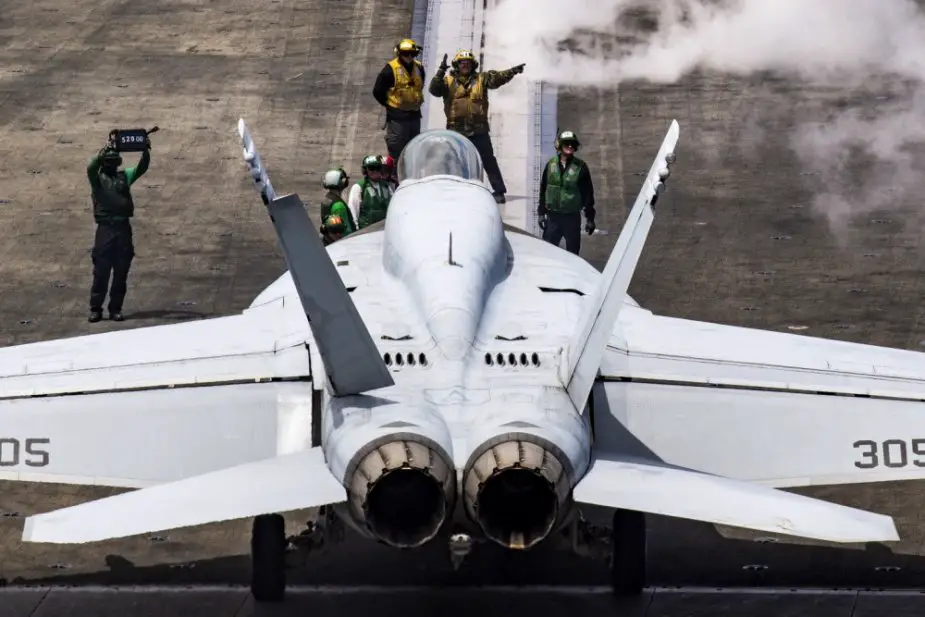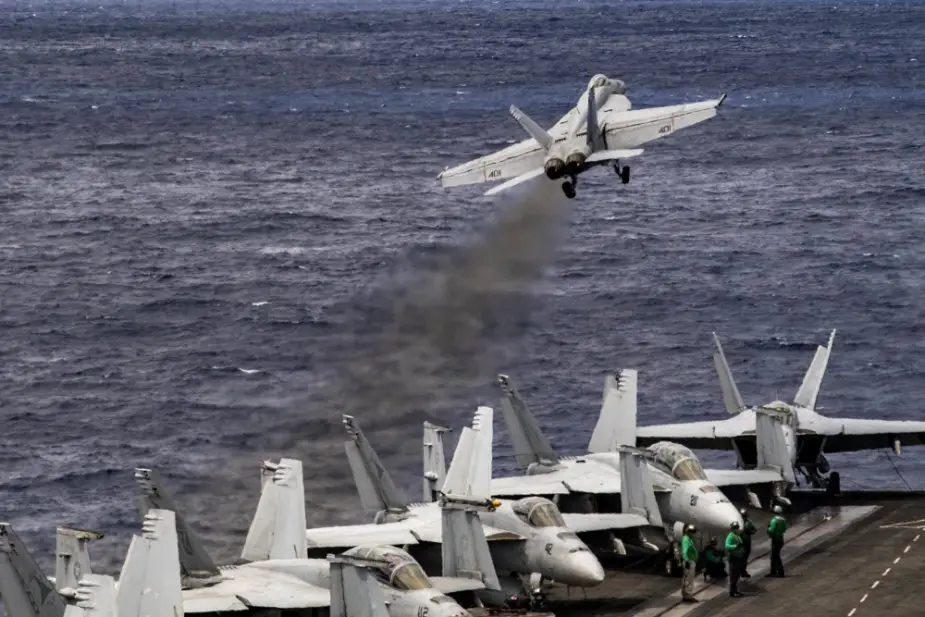The Harry S. Truman Carrier Strike Group, underway in the Atlantic Ocean, conducted a week of naval air integration exercises with Marine Corps elements assigned to the 2nd Marine Aircraft Wing May 12-18, 2020.
Follow Navy Recognition on Google News at this link
 An F/A-18E Super Hornet, assigned to the "Sunliners" of Strike Fighter Squadron (VFA) 81, launches from the flight deck of the Nimitz-class aircraft carrier USS Harry S. Truman (CVN 75) in the Atlantic Ocean May 12, 2020 (Picture source: Photo By Petty Officer 2nd Class Tamara Vaughn/US Navy)
An F/A-18E Super Hornet, assigned to the "Sunliners" of Strike Fighter Squadron (VFA) 81, launches from the flight deck of the Nimitz-class aircraft carrier USS Harry S. Truman (CVN 75) in the Atlantic Ocean May 12, 2020 (Picture source: Photo By Petty Officer 2nd Class Tamara Vaughn/US Navy)
The purpose of the high-end training was to improve Navy and Marine Corps integration, communication, power projection in the form of strikes, and enhance readiness of air defense assets.
The HSTCSG is comprised of the flagship Nimitz-class aircraft carrier USS Harry S. Truman (CVN 75) and the embarked squadrons of Carrier Air Wing (CVW) 1, Ticonderoga-class guided-missile cruiser USS Normandy (CG 60) and Arleigh Burke-class guided-missile destroyer USS Forrest Sherman (DDG 98).
Marine Corps support included F/A-18C Hornets assigned to Marine Aircraft Group (MAG) 31, based out of Marine Corps Air Station Beaufort, South Carolina, and AV-8B Harriers assigned to (MAG) 14, based out of MCAS Cherry Point, North Carolina.
 An F/A-18E Super Hornet, assigned to the "Sunliners" of Strike Fighter Squadron (VFA) 81, launches from the flight deck of the Nimitz-class aircraft carrier USS Harry S. Truman (CVN 75) in the Atlantic Ocean May 12, 2020 (Picture source: Photo By Petty Officer 2nd Class Tamara Vaughn/US Navy)
An F/A-18E Super Hornet, assigned to the "Sunliners" of Strike Fighter Squadron (VFA) 81, launches from the flight deck of the Nimitz-class aircraft carrier USS Harry S. Truman (CVN 75) in the Atlantic Ocean May 12, 2020 (Picture source: Photo By Petty Officer 2nd Class Tamara Vaughn/US Navy)
The week of day and night-time integration started with close air support exercises, in which Marine ground forces coordinated with Navy strike fighter aircraft to strike a precision target. During the close air support event, ground forces used combat communication with Navy aircraft to strike the targets, while sharpening tactics. The integration of Marine Corps shore-based elements with deployed naval assets showcased the ability of both teams to fight together as a united naval expeditionary force.
The coordination continued with high-end training during multiple air defense exercises and large force strikes over the course of the week. In one of the multiple events, over twenty CVW-1 aircraft including F/A-18E/F Super Hornets, E/A-18 Growlers, and E2D Hawkeyes faced off against a similar numbers of USMC F/A-18C Hornets and A/V-8B Harriers to conduct defensive and offensive counter-air and strike missions in support of the carrier strike group and National level tasking. The Navy and Marine Corps aircraft took turns simulating the enemy “red force” versus the U.S. “blue force” and executed advanced combat tactics.
The Harry S. Truman Carrier Strike Group (HSTCSG) remains at sea in the Atlantic as a certified carrier strike group force ready for tasking in order to protect the crew from the risks posed by COVID-19, following their successful deployment to the U.S. 5th and 6th Fleet areas of operation. Keeping HSTCSG at sea in U.S. 2nd Fleet, in the sustainment phase of OFRP, allows the ship to maintain a high level of readiness during the global COVID-19 pandemic.



